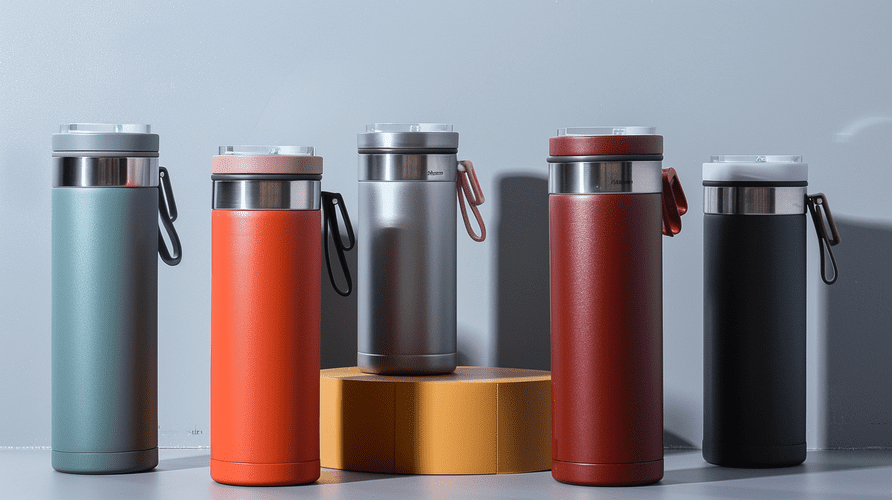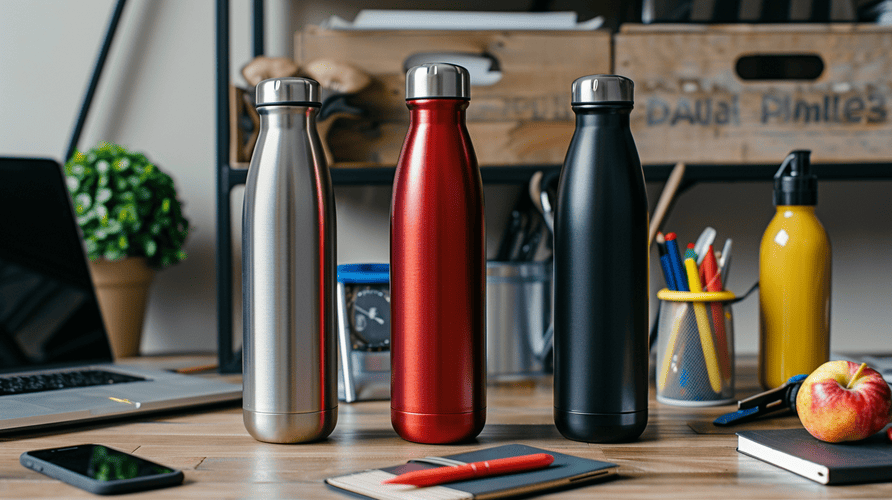Plastic bottles are everywhere, choking our landfills and oceans. Feeling frustrated by this waste? Making the simple switch to a stainless steel water bottle creates a positive environmental impact.
Switching significantly reduces plastic waste. Stainless steel bottles are durable, reusable for years, and highly recyclable. This drastically lowers your long-term environmental footprint compared to relying on single-use plastics.

Many of our clients, procurement managers like Mark Shenng from Canada or startup founders launching new brands, often ask about the real environmental benefits. They need reliable products and want to make responsible choices. It's a critical question, especially when building a brand image around sustainability. Let's dig into the details to see why this change is so important, both for business and for the planet we share.
Are stainless steel water bottles environmentally friendly?
You see "eco-friendly" labels everywhere, it can be confusing. Wondering if stainless steel truly lives up to the hype? Yes, its durability and recyclability make it a genuinely sustainable choice.
Stainless steel bottles earn their environmentally friendly1 status mainly because one bottle can replace hundreds, even thousands, of single-use plastic ones over its lifetime. They last for years and steel is effectively recycled, minimizing landfill burden.

When considering if something is "environmentally friendly," we need to look at its entire lifecycle. It's true that producing stainless steel requires energy, but this has to be weighed against its long-term benefits.
Production Energy vs. Long-Term Use
Making stainless steel involves mining iron ore, chromium, and sometimes nickel. Smelting and forming these metals into a bottle uses a significant amount of energy. This initial energy cost is higher than producing a single plastic bottle. However, the key difference is reusability. You might use a stainless steel bottle daily for five, ten, or even more years. A plastic bottle is typically used once. The environmental cost of constantly producing, transporting, and disposing of single-use plastic bottles quickly surpasses the one-time impact of making a durable steel bottle. The break-even point, where the steel bottle becomes the better environmental choice, is reached relatively quickly – often within a few months of regular use compared to buying bottled water.
Recyclability Facts
Stainless steel is one of the most recycled materials on the planet. Unlike many types of plastic which get downcycled (made into lower quality products) or aren't recycled at all, steel can be melted down and reformed into high-quality steel again and again without losing its properties. Recycling steel uses significantly less energy than producing it from raw materials – estimates often cite around 70-75% energy savings. This closed-loop potential is a major environmental advantage. For businesses like Mark's, highlighting the recyclability2 of the product adds another layer to their sustainable brand narrative. It assures their customers that the product's end-of-life is also considered.
Does stainless steel affect the environment?
Hearing about mining and metal processing might raise concerns. Worried about the environmental footprint of steel production itself? While manufacturing does have impacts, responsible practices and steel's lifecycle greatly minimize harm.
Yes, producing stainless steel3 does affect the environment, mainly through mining raw materials and the energy used in manufacturing. But, its incredible durability and high recyclability mean its total lifetime environmental impact is considerably lower than single-use alternatives.

It's important to be transparent about the entire process. No manufacturing is completely impact-free, but understanding the specifics helps put stainless steel's footprint into perspective, especially for buyers focused on quality and certification.
Resource Extraction and Energy
The primary components of stainless steel are iron ore, chromium, and nickel. Mining these resources inevitably disrupts local ecosystems and requires energy. Transforming these raw materials into finished steel in foundries is also energy-intensive. As manufacturers, we at Icobottle are conscious of this. We work with suppliers who prioritize responsible sourcing and increasingly incorporate recycled steel content into production. Using recycled steel drastically reduces the need for new mining and lowers the overall energy consumption. We often discuss sourcing transparency and certifications with clients like Mark, ensuring they understand the steps taken to mitigate these initial impacts.
End-of-Life Scenarios
What happens when a stainless steel bottle eventually reaches the end of its usable life?
- Recycling: This is the ideal scenario. Steel is easily separated magnetically and recycled efficiently in most municipal systems. It gets melted down and reused, conserving resources and energy.
- Landfill: If a steel bottle somehow ends up in a landfill, it's relatively benign compared to plastic. It is stable and inert, meaning it won't break down into microparticles or leach harmful chemicals into the soil or water over time. It will eventually rust, returning iron oxide to the earth, but it doesn't pose the same long-term pollution threat as plastics.
Comparison with Other Reusables
How does steel stack up against other reusable options like aluminum or glass?
- Aluminum: Also highly recyclable and lighter than steel, but generally less durable (dents easily) and the initial production is even more energy-intensive than steel.
- Glass: Inert and recyclable, but heavy, breakable, and not always accepted in curbside recycling programs depending on the region. Its fragility makes it less practical for active daily use.
Stainless steel often hits the sweet spot: excellent durability, good recyclability, inert material, and practical for everyday carry.
Why should we switch to metal water bottles?
Grabbing a plastic water bottle can feel automatic, a hard habit to break. Still find yourself reaching for single-use options? Switching to metal, like stainless steel, provides strong environmental, health, and even financial reasons.
You should switch to metal water bottles4 primarily to drastically cut down on plastic waste pollution. Additionally, you avoid potential chemical exposure (like BPA), save money compared to buying bottled water, and get a highly durable, long-lasting product.

The reasons to switch extend beyond just being "green." They touch on personal well-being, financial sense, and practical advantages, making it a compelling choice for individuals and businesses promoting sustainable practices.
Reducing Plastic Pollution
This is often the biggest motivator. Each person switching to a reusable bottle can prevent hundreds, potentially thousands, of single-use plastic bottles from entering the waste stream each year. I remember visiting a beautiful coastline years ago, only to see the high-tide line littered with plastic debris – countless bottles among it. That image sticks with you. Reducing this visible pollution that harms wildlife and ecosystems is a powerful reason for change. By choosing reusable steel, we directly decrease demand for single-use plastic production.
Health and Safety Advantages
Food-grade stainless steel (like the 18/8 or 304 grades we use at Icobottle) is non-reactive. It doesn't leach chemicals into your water, even if the liquid is hot or acidic. Many plastics, especially older or cheaper ones, can contain BPA or other endocrine disruptors that raise health concerns. Steel bottles are also generally easier to clean thoroughly and less likely to harbor bacteria or odors compared to porous plastic surfaces. This health aspect is a significant benefit for daily hydration.
Economic and Practical Benefits
Think about the cost of bottled water. Even buying cases cheaply adds up significantly over a year. Filling a reusable stainless steel bottle from the tap costs virtually nothing. The bottle pays for itself quickly. Furthermore, stainless steel is incredibly durable. It resists drops, bumps, and punctures far better than plastic or glass. Insulated stainless steel bottles also offer the practical benefit of keeping drinks hot or cold for hours, adding convenience to daily life. For businesses, providing employees or clients with high-quality, branded stainless steel bottles is a practical gift that promotes brand visibility and aligns the company with values of sustainability and well-being. It's a tangible demonstration of corporate responsibility.
Is stainless steel better for the environment than plastic?
Plastic bottles seem convenient and inexpensive upfront. Is the shift to stainless steel really worth the environmental benefit? Absolutely, stainless steel has a significantly lower environmental impact over its full lifecycle.
Yes, stainless steel is substantially better for the environment compared to single-use plastic bottles. Its reusability eliminates massive amounts of waste and conserves resources. Plastic production relies heavily on fossil fuels and contributes to persistent pollution like microplastics.

Comparing the two requires looking beyond just the initial product. We need to consider the entire journey from raw materials to disposal – what's known as a lifecycle assessment5.
Lifecycle Comparison: Key Stages
Let's break down the environmental impacts at different stages using a simple comparison:
| Lifecycle Stage | Stainless Steel Bottle | Single-Use Plastic Bottle (PET) |
|---|---|---|
| Raw Materials | Mining iron ore, chromium, nickel | Fossil fuels (oil, natural gas) |
| Production | Energy-intensive smelting & forming | Less energy per bottle, but massive scale |
| Transportation | Higher weight impacts fuel use initially | Lower weight, but constant distribution |
| Use Phase | Reusable hundreds/thousands of times | Typically used once |
| End-of-Life | Highly recyclable (closed loop potential) | Low recycling rates, often downcycled, landfill persistence |
While steel has higher impacts in the initial production phase, its longevity and recyclability heavily outweigh the continuous production, use, and disposal cycle of single-use plastic.
The Reusability Factor
This is the single most critical difference. A single person switching to a reusable steel bottle and using it daily can easily avoid using over 150 plastic bottles per year. Multiply that by millions of people, and the reduction in plastic production, transportation emissions, and waste generation becomes enormous. This long use phase makes the initial energy investment in steel worthwhile many times over.
Microplastics: The Hidden Cost of Plastic
Beyond the visible waste, plastic bottles break down over time into tiny fragments called microplastics6. These particles contaminate our water, soil, air, and even our bodies, with largely unknown long-term health effects. Studies show plastic bottles themselves can shed microplastics into the water they contain. Stainless steel does not degrade in this way and poses no threat of microplastic pollution, offering another crucial environmental and health advantage. For businesses concerned about product safety and long-term environmental liability, this is a key consideration.
Conclusion
Making the switch to stainless steel water bottles is a clear positive choice. It significantly cuts waste, conserves vital resources, and ultimately contributes to a healthier planet for everyone. Choose reusable.
-
Explore this link to understand the environmental benefits of stainless steel bottles and how they compare to plastic alternatives. ↩
-
Learn about the recyclability of stainless steel and its advantages over plastic recycling processes. ↩
-
Explore the environmental effects of stainless steel production and its lifecycle to understand its sustainability better. ↩
-
Explore the benefits of metal water bottles for health, environment, and cost savings. Discover why this switch is essential for sustainability. ↩
-
Understand the importance of lifecycle assessments in evaluating environmental impacts, essential for sustainable decision-making. ↩
-
Learn about the hidden dangers of microplastics and their effects on health and the environment, crucial for informed choices. ↩

